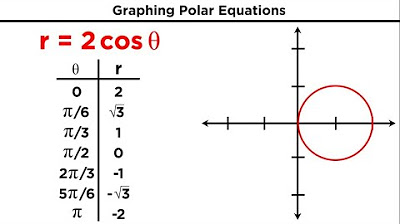An Example Using Polar Coordinates | Physics with Professor Matt Anderson | M3-09
TLDRIn this instructional video, Professor Anderson explores the conversion of Cartesian coordinates (-3, 4) to polar coordinates. He explains the concepts of r (distance from the origin) and theta (angle from the x-axis), using the example to demonstrate how to calculate r with the Pythagorean theorem, resulting in 5, and theta using the arccosine of the ratio of the adjacent side to the hypotenuse, yielding an angle of 127 degrees. The video is designed to clarify the process of converting between coordinate systems and understanding the underlying trigonometric relationships.
Takeaways
- 📍 The script is a lecture on converting Cartesian coordinates (x, y) to polar coordinates (r, θ).
- 📌 The example given is for the Cartesian coordinates (-3, 4), located in the second quadrant.
- 📐 The distance from the origin (r) is calculated using the Pythagorean theorem: √(x^2 + y^2), resulting in r = 5.
- 📐 The angle (θ) is determined by the counter-clockwise angle from the positive x-axis, which in this case is 127 degrees.
- 🔢 The coordinates (-3, 4) are plotted by marking off -3 on the x-axis and 4 on the y-axis to find the intersection point.
- 📈 The relationship between Cartesian and polar coordinates is explained using trigonometric relations.
- 📊 A right triangle with sides 3 and 4 is recognized as a 3-4-5 triangle, a special Pythagorean triple.
- 🧮 The calculation of r confirms that the square root of the sum of the squares of x and y gives the same result, regardless of their signs.
- 🌟 The angle θ is found by subtracting the angle φ (53 degrees) from 180 degrees to get the final angle in polar coordinates.
- 🤔 The choice of trigonometric function (sine, cosine, tangent) to calculate θ is discussed, with cosine being the chosen method.
- 📚 The lecture emphasizes the importance of understanding the relationships between the different quadrants and the trigonometric functions.
Q & A
What is the significance of polar coordinates in the context of the given problem?
-Polar coordinates are a two-dimensional coordinate system in which each point is determined by a distance from a reference point and an angle from a reference direction. In the problem, polar coordinates are used to describe the location of a point (-3, 4) in terms of its radial distance (r) from the origin and the angle (theta) it makes with the positive x-axis.
What are the coordinates given in the problem?
-The coordinates given in the problem are x = -3 and y = 4.
How is the point (-3, 4) located in the Cartesian coordinate system?
-The point (-3, 4) is located in the second quadrant of the Cartesian coordinate system.
What does 'r' represent in polar coordinates?
-In polar coordinates, 'r' represents the radial distance from the origin to the point.
What does 'theta' represent in polar coordinates?
-In polar coordinates, 'theta' represents the angle measured counterclockwise from the positive x-axis to the line connecting the origin to the point.
How is the value of 'r' calculated in the given problem?
-The value of 'r' is calculated using the Pythagorean theorem: r = √(x^2 + y^2). For the point (-3, 4), r = √((-3)^2 + 4^2) = √(9 + 16) = √25 = 5.
What is the significance of the 3-4-5 triangle in calculating 'r'?
-The 3-4-5 triangle is a Pythagorean triple, which means that the squares of the two shorter sides (3 and 4) sum up to the square of the longest side (5). This is a special right triangle that helps to easily calculate 'r' without a calculator for the given point (-3, 4).
How is the angle 'theta' calculated in the given problem?
-Theta is calculated using the cosine function from trigonometry. Specifically, θ = arccos(Adjacent side / Hypotenuse). For the triangle formed by the x-coordinate (-3), y-coordinate (4), and the hypotenuse 'r' (5), θ = arccos(3/5) ≈ 53.1 degrees.
What is the relationship between 'phi' and 'theta' in the context of the problem?
-In the context of the problem, 'phi' is the smaller angle formed by the x-axis, the line connecting the origin to the point (-3, 4), and the hypotenuse 'r'. 'Theta' is the larger angle that the point makes with the positive x-axis. The relationship between 'phi' and 'theta' is such that phi + theta = 180 degrees.
What is the final value of 'theta' for the point (-3, 4)?
-After calculating 'phi' as approximately 53.1 degrees, 'theta' is found by subtracting 'phi' from 180 degrees. Thus, theta = 180 - 53.1 ≈ 126.9 degrees, which can be rounded to 127 degrees.
What is the role of trigonometric functions in solving this problem?
-Trigonometric functions play a crucial role in converting Cartesian coordinates to polar coordinates. In this problem, the cosine function is used to calculate the angle 'theta' by relating the adjacent side (x-coordinate) and the hypotenuse (r) of the right triangle formed by the point and the origin.
Why is it important to understand the relationship between Cartesian and polar coordinates?
-Understanding the relationship between Cartesian and polar coordinates is important as it allows for the analysis of problems from different perspectives, especially in fields like physics, engineering, and mathematics where problems often involve circular or radial symmetry. Being able to convert between these coordinate systems enables the simplification and solving of complex problems.
Outlines
📐 Introduction to Polar Coordinates
The first paragraph introduces the concept of polar coordinates through a simple example. Professor Anderson begins by plotting the coordinates (-3, 4) on the Cartesian plane, identifying the quadrant where the point lies. The discussion then shifts to finding the values of r (the radial distance from the origin) and θ (the angle from the x-axis). The professor uses trigonometric relations to relate x and y to r and θ, and visually represents this with a triangle. The Pythagorean theorem is applied to find r, resulting in a value of 5. The explanation emphasizes the importance of understanding the relationship between Cartesian and polar coordinates.
📐 Calculating Theta Using Trigonometric Functions
In the second paragraph, the focus is on determining the value of θ. The professor explains that θ represents the larger angle, which is greater than 90 degrees, and relates it to the smaller angle φ in the triangle formed by the x, y coordinates, and the origin. By establishing that φ plus θ equals 180 degrees, the professor guides the students to find φ first. The cosine function is chosen to calculate φ, using the adjacent side (3) and the hypotenuse (r = 5). The arc cosine of 3/5 yields an angle of 53.1 degrees. Subtracting this from 180 degrees gives the value of θ as 127 degrees. The summary ends with an invitation for students to ask questions during office hours, emphasizing the professor's availability for further clarification.
Mindmap
Keywords
💡Polar Coordinates
💡Quadrant
💡Trigonometric Relations
💡Hypotenuse
💡Theta
💡Right Triangle
💡Pythagorean Theorem
💡Cosine
💡Arc Cosine
💡Cartesian Coordinates
💡Angle of Depression
Highlights
Introduction to polar coordinates and their application in solving problems.
Using a specific example of Cartesian coordinates (x = -3, y = 4) to find polar coordinates.
Identifying the quadrant of the given coordinates to understand the position relative to the origin.
Explanation of 'r' as the distance from the origin and 'theta' as the angle from the x-axis.
Visualizing the problem by marking off the x and y values on a coordinate system.
Deriving the value of 'r' using the Pythagorean theorem for a 3-4-5 right triangle.
Confirmation that 'r' remains the same even if x is negative due to squaring in the calculation.
Discussion on determining 'theta' for an angle larger than 90 degrees.
Using the relationship between 'phi' and 'theta' where 'phi + theta = 180 degrees'.
Calculating 'theta' by finding the complement of 'phi' (180 - phi).
Using the cosine function to calculate 'phi' from the sides of the triangle.
Applying the arc cosine function to find the value of 'phi'.
Final calculation of 'theta' as 127 degrees after determining 'phi'.
Offering assistance for further clarification through office hours.
Transcripts
Browse More Related Video

Polar Coordinate System | Physics with Professor Matt Anderson | M3-02

Polar coordinates 1 | Parametric equations and polar coordinates | Precalculus | Khan Academy

Polar coordinates 2 | Parametric equations and polar coordinates | Precalculus | Khan Academy

Calculus 2: Polar Coordinates (Video #30) | Math with Professor V

Lesson 14 - Polar Equations (Calculus 2 Tutor)

Polar Coordinates and Graphing Polar Equations
5.0 / 5 (0 votes)
Thanks for rating: